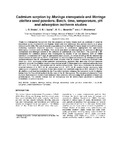| dc.contributor.author | Mataka, L.M. | |
| dc.contributor.author | Sajidu, S.M.I. | |
| dc.contributor.author | Masamba, W.R.L. | |
| dc.contributor.author | Mwatseteza, J.F. | |
| dc.date.accessioned | 2011-04-13T09:43:53Z | |
| dc.date.available | 2011-04-13T09:43:53Z | |
| dc.date.issued | 2010-05 | |
| dc.identifier.citation | Mataka, L.M. et al (2010) Cadmium sorption by Moringa stenopetala and Moringa oleifera seed powders: Batch, time, temperature, pH and adsorption isotherm studies, International Journal of Water Resources and Environmental Engineering, Vol.2, No.3, pp. 50-59 | en_US |
| dc.identifier.uri | http://hdl.handle.net/10311/786 | |
| dc.description.abstract | There is a widespread recognition that the presence of heavy metals such as cadmium in water is hazardous to the environment and human health and their discharge into surface waters is of great concern worldwide. The use of natural coagulants such as Moringa for heavy metal removal from water replacing expensive imported synthetic coagulants is particularly appropriate for agro-based developing countries such as Malawi. This study was aimed at investigating the potential of Moringa stenopetala and Moringa oleifera in the removal of cadmium(II) ions from water. The potential of Mstenopetala for cadmium removal was investigated by means of jar test beakers. With an initial cadmium concentration of 7 mg/l,M. stenopetala seed powder, at a dose of 2.50 g/100 ml, reduced the concentration of cadmium by 53.8%. Comparison of removal capacities between M. stenopetala and Moleifera indicated that M. stenopetala was more effective than M. oleifera in removing cadmium from water (p < 0.05). Increasing initial cadmium concentration, agitation time and ionic strength reduced cadmium removal. Equilibrium sorption was attained at pH 5 where maximum cadmium removals were 82.7 and 70.7% using M. stenopetala and M. oleifera respectively. There was a reduction in cadmium removal between 0 to 60°C for M. stenopetala and 0 - 40°C for M. oleifera before increasing with subsequent temperature increases. It was also shown that cadmium sorption at 30°C and pH 3 for the M. oleifera could best be modelled by the Freundlich isotherm whereas the Langmuir model is slightly better than the Freundlich isotherm in the case of the M. Stenopetala. The energies of adsorption from Dubinin-Radushkevich models have indicated that cadmium removal using both powders is based on physisorption. The results indicate that M. stenopetala and M. oleifera have potential in cadmium remediation of polluted waters. | en_US |
| dc.language.iso | en | en_US |
| dc.publisher | Academic Journals: http://www.academicjournals.org/ | en_US |
| dc.subject | Cadmium | en_US |
| dc.subject | Moringa oleifera | en_US |
| dc.subject | Moringa stenopetala | en_US |
| dc.subject | Water pollution | en_US |
| dc.subject | Remediation | en_US |
| dc.title | Cadmium sorption by Moringa stemopetala and Moringa oleifera seed powders: Batch, time, temperature, pH and adsorption isotherm studies | en_US |
| dc.type | Published Article | en_US |
| dc.link | http://www.academicjournals.org/ijwree/contents/2010%20content/May.htm | en_US |

